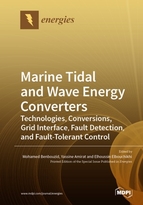Marine Tidal and Wave Energy Converters: Technologies, Conversions, Grid Interface, Fault Detection, and Fault-Tolerant Control
A special issue of Energies (ISSN 1996-1073). This special issue belongs to the section "A3: Wind, Wave and Tidal Energy".
Deadline for manuscript submissions: closed (20 May 2019) | Viewed by 26693
Special Issue Editors
Interests: fault detection and diagnosis; failure prognosis; cyberattack detection; fault-resilient control; machine learning
Special Issues, Collections and Topics in MDPI journals
Interests: electric machines and drives; tidal and wave power; wind power; fault detection and diagnosis; fault-tolerant control; microgrids; smart grids
Special Issues, Collections and Topics in MDPI journals
Interests: electrical machine fault detection and diagnosis; fault-tolerant control; signal processing and statistics for power system monitoring; energy management systems in microgrids based on renewables; power electronics; microgrids; renewable energy; energy management systems; EV charging stations
Special Issues, Collections and Topics in MDPI journals
Special Issue Information
Dear Colleagues,
The worldwide potential of electric power generation from marine tidal currents and waves is enormous. The high load factor resulting from the fluid properties and the predictable resource characteristics make these energy resources attractive and advantageous for power generation and advantageous when compared to other renewable energies. These technologies are just beginning to reach technical and economic viability to make them potential commercial power sources in the near future. While just a few small projects currently exist, the technology is advancing rapidly and has huge potential for generating bulk power. Moreover, international treaties related to climate control and dwindling fossil fuel resources have encouraged the harnessing of energy sustainably from such marine renewable sources. Several demonstrative projects have been scheduled to capture tidal and wave energies. A number of these projects have now reached a relatively mature stage and are close to completion. However, very little is known in the academic world about these technologies beyond the basics of the energy conversion principle. While research emphasis is more towards hydrodynamics and turbine design, very limited activities are witnessed in the power conversion interface, control, and power quality aspects, which are of vital importance for their successful integration to the grid or to standalone microgrid. Regarding this emerging and promising area of research, this Special Issue is aimed at promoting fruitful experience interchanges and discussions on how to improve marine tidal and wave energy converters’ behavior.
Prof. Mohamed Benbouzid
Dr. Yassine Amirat
Dr. Elhoussin Elbouchikhi
Guest Editors
Manuscript Submission Information
Manuscripts should be submitted online at www.mdpi.com by registering and logging in to this website. Once you are registered, click here to go to the submission form. Manuscripts can be submitted until the deadline. All submissions that pass pre-check are peer-reviewed. Accepted papers will be published continuously in the journal (as soon as accepted) and will be listed together on the special issue website. Research articles, review articles as well as short communications are invited. For planned papers, a title and short abstract (about 100 words) can be sent to the Editorial Office for announcement on this website.
Submitted manuscripts should not have been published previously, nor be under consideration for publication elsewhere (except conference proceedings papers). All manuscripts are thoroughly refereed through a single-blind peer-review process. A guide for authors and other relevant information for submission of manuscripts is available on the Instructions for Authors page. Energies is an international peer-reviewed open access semimonthly journal published by MDPI.
Please visit the Instructions for Authors page before submitting a manuscript. The Article Processing Charge (APC) for publication in this open access journal is 2600 CHF (Swiss Francs). Submitted papers should be well formatted and use good English. Authors may use MDPI's English editing service prior to publication or during author revisions.
Keywords
- Multiphysics modeling of marine renewable energy converters
- Design of specific electric generator for marine renewable energy converters
- Power electronics for marine renewable energy converters
- Control strategies for marine renewable energy converters
- Energy storage systems for marine renewable energy converters
- Tidal and wave energy farms: Architecture optimization, reliability, and grid connection
- Failure monitoring in generators and power electronics used by marine renewable energy converters
- Resilience or fault-tolerant control








